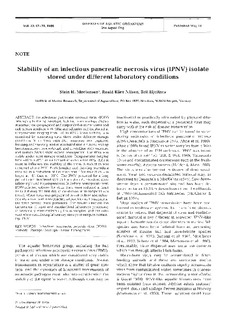Stability of an infectious pancreatic necrosis virus (IPNV) isolate stored under different laboratory conditions
Journal article, Peer reviewed
Permanent lenke
http://hdl.handle.net/11250/108328Utgivelsesdato
1998-05-14Metadata
Vis full innførselSamlinger
- Articles [3012]
Originalversjon
http://dx.doi.org/10.3354/dao033067Sammendrag
An infectious pancreatic necrosis virus (IPNV) belonging to the Sp serotype, isolated from scallops Pecten maximus, was propagated and suspended in sterile water and cell culture medium with different salinities and incubated at temperatures ranging from -80 to 40 degrees C. Virus stability was examined by measuring virus titers under different storage conditions. Virus titers were also measured after repeated freezing and thawing, and in incubated sterile filtered scallop hepatopancreas, haemolymph and crystalline style samples, and salmon Salmo salar kidney homogenate. The virus was stable under most storage conditions. Temperatures ranging from -80 to +20 degrees C, as well as salinities from 0 to 40 parts per thousand, did not seem to influence the stability of the virus. A reduction was observed above 20 degrees C. Each freezing and thawing procedure resulted in a reduction of the virus titer. This reduction was larger at -80 than at -20 degrees C. The IPNV persisted for a long period in sterile filtered scallop haemolymph, dissolved crystalline style and hepatopancreas. In kidney homogenate from IPNV-infected salmon the virus titers were reduced at least 10-fold during the first day of incubation at all temperatures tested. When virus was propagated in cell culture and subsequently mixed with non-infected salmon kidney homogenate, the virus proved more persistent. Our results illustrate the importance of rapid and standardised laboratory processing of potentially virus-containing tissue samples, and are relevant when considering laboratory storage of samples containing IPNV.
